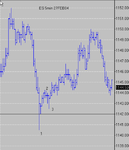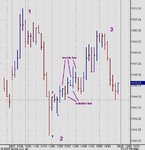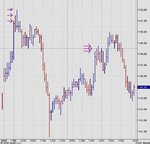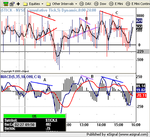- Messages
- 2,325
- Likes
- 17
stoploss:
To answer your questions
1. Yes I did. How? Just something I've noticed is that the market very rarely drops more than 10 points without a jolly good pullback. So the high was at 1152, so while the price was dropping quite fast I had in mind 1142 or thereabouts for the bottom of that drop, with 1140 as definite support. I was watching the volume tick up (or shoot up, rather), and you can often sense a last-minute panic which also helps identify the bottom.
2. Yes, very true. However, the 10 min chart didn't have a lower low. I did short between green 2 and green 3, but only for a swift trade because the price was, by then, in an up-trend. There were lots of other reasons, too, such as the 'top' at green point 2 was messy, which usually indicates a small pullback, not a proper turn. It's difficult to describe.
To answer your questions
1. Yes I did. How? Just something I've noticed is that the market very rarely drops more than 10 points without a jolly good pullback. So the high was at 1152, so while the price was dropping quite fast I had in mind 1142 or thereabouts for the bottom of that drop, with 1140 as definite support. I was watching the volume tick up (or shoot up, rather), and you can often sense a last-minute panic which also helps identify the bottom.
2. Yes, very true. However, the 10 min chart didn't have a lower low. I did short between green 2 and green 3, but only for a swift trade because the price was, by then, in an up-trend. There were lots of other reasons, too, such as the 'top' at green point 2 was messy, which usually indicates a small pullback, not a proper turn. It's difficult to describe.





